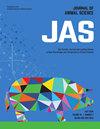大白猪产仔数性状的显性和上位遗传效应的基因组预测
IF 2.7
2区 农林科学
Q1 AGRICULTURE, DAIRY & ANIMAL SCIENCE
引用次数: 0
摘要
母猪产仔数性状对养猪业的经济效益至关重要。对1206头大白猪(LW)的总出生数(TNB)、出生活仔数(NBA)和健康仔猪数(NHP) 3个表型性状进行了记录。我们评估了一系列基因组最佳线性无偏预测(GBLUP)模型,这些模型依次添加了可加性效应(模型a)、显性效应(模型a +D)和上位效应(模型a +D+AA、模型a +D+AA+AD和模型a +D+AA+AD+DD),利用芯片数据和输入的全基因组测序(WGS)数据来估计遗传参数和预测精度。本研究母猪繁殖性状遗传力较低,3个性状的窄遗传力为0.030 ~ 0.064,宽遗传力为0.125 ~ 0.145。模型中非加性效应的加入提高了基因组选择的准确性。在芯片数据中,与A模型相比,A+D+AA+AD+DD模型对TNB、NBA和NHP的准确率提高幅度最大,分别提高了1.78、1.67和1.74%。此外,与芯片数据相比,输入的WGS数据的准确性更高。对于TNB、NBA和NHP性状,输入WGS数据的预测准确率分别比芯片数据提高了3.26%、7.72%和3.00%。综上所述,这些结果表明基因组选择中的非加性效应可以提高预测精度,在猪基因组评估过程中应予以考虑。本文章由计算机程序翻译,如有差异,请以英文原文为准。
Genomic prediction accounting for dominance and epistatic genetic effects on litter size traits in Large White pigs
Litter size traits of sows are crucial for the economic benefits of the pig industry. Three phenotypic traits of 1,206 Large White (LW) pigs, that is, the total number born (TNB), number born alive (NBA), and number of healthy piglets (NHP), were recorded. We evaluated a series of genomic best linear unbiased prediction (GBLUP) models that sequentially added additive effects (model A), dominance effects (model A+D), and epistatic effects (model A+D+AA, model A+D+AA+AD, and model A+D+AA+AD+DD) using chip data and imputed whole-genome sequencing (WGS) data to estimate genetic parameters and predictive accuracy. The reproductive traits of sows showed low heritability in this study, with narrow heritability of the three traits ranging from 0.030 to 0.064, and broad heritability ranging from 0.125 to 0.145. The inclusion of non-additive effects in the model improved the accuracy of genomic selection. In the chip data, compared with that of the A model, the A+D+AA+AD+DD model showed the greatest increase in accuracy for TNB, NBA, and NHP, with improvements of 1.78, 1.67, and 1.74%, respectively. Additionally, the accuracy of the imputed WGS data was greater compared to the chip data. For the TNB, NBA, and NHP traits, the predictive accuracy of the imputed WGS data improved by 3.26, 7.72, and 3.00%, respectively, compared with that of the chip data. In summary, these results suggest that non-additive effects in genomic selection could improve prediction accuracy and should be considered in pig genomic evaluation procedures.
求助全文
通过发布文献求助,成功后即可免费获取论文全文。
去求助
来源期刊

Journal of animal science
农林科学-奶制品与动物科学
CiteScore
4.80
自引率
12.10%
发文量
1589
审稿时长
3 months
期刊介绍:
The Journal of Animal Science (JAS) is the premier journal for animal science and serves as the leading source of new knowledge and perspective in this area. JAS publishes more than 500 fully reviewed research articles, invited reviews, technical notes, and letters to the editor each year.
Articles published in JAS encompass a broad range of research topics in animal production and fundamental aspects of genetics, nutrition, physiology, and preparation and utilization of animal products. Articles typically report research with beef cattle, companion animals, goats, horses, pigs, and sheep; however, studies involving other farm animals, aquatic and wildlife species, and laboratory animal species that address fundamental questions related to livestock and companion animal biology will be considered for publication.
 求助内容:
求助内容: 应助结果提醒方式:
应助结果提醒方式:


